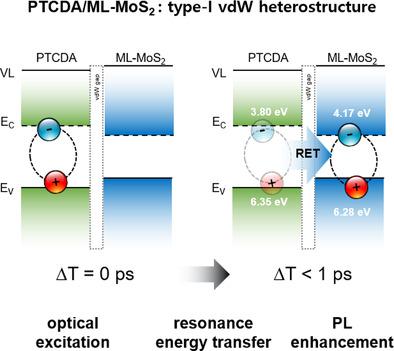Our official English website, www.x-mol.net, welcomes your feedback! (Note: you will need to create a separate account there.)
Type-I Energy Level Alignment at the PTCDA—Monolayer MoS2 Interface Promotes Resonance Energy Transfer and Luminescence Enhancement
Advanced Science ( IF 15.1 ) Pub Date : 2021-05-05 , DOI: 10.1002/advs.202100215 Soohyung Park 1 , Niklas Mutz 2 , Sergey A Kovalenko 3 , Thorsten Schultz 2, 4 , Dongguen Shin 2 , Areej Aljarb 5 , Lain-Jong Li 6 , Vincent Tung 5 , Patrick Amsalem 2 , Emil J W List-Kratochvil 2, 3, 4 , Julia Stähler 3 , Xiaomin Xu 7 , Sylke Blumstengel 2, 3 , Norbert Koch 2, 4
Advanced Science ( IF 15.1 ) Pub Date : 2021-05-05 , DOI: 10.1002/advs.202100215 Soohyung Park 1 , Niklas Mutz 2 , Sergey A Kovalenko 3 , Thorsten Schultz 2, 4 , Dongguen Shin 2 , Areej Aljarb 5 , Lain-Jong Li 6 , Vincent Tung 5 , Patrick Amsalem 2 , Emil J W List-Kratochvil 2, 3, 4 , Julia Stähler 3 , Xiaomin Xu 7 , Sylke Blumstengel 2, 3 , Norbert Koch 2, 4
Affiliation

|
Van der Waals heterostructures consisting of 2D semiconductors and conjugated molecules are of increasing interest because of the prospect of a synergistic enhancement of (opto)electronic properties. In particular, perylenetetracarboxylic dianhydride (PTCDA) on monolayer (ML)-MoS2 has been identified as promising candidate and a staggered type-II energy level alignment and excited state interfacial charge transfer have been proposed. In contrast, it is here found with inverse and direct angle resolved photoelectron spectroscopy that PTCDA/ML-MoS2 supported by insulating sapphire exhibits a straddling type-I level alignment, with PTCDA having the wider energy gap. Photoluminescence (PL) and sub-picosecond transient absorption measurements reveal that resonance energy transfer, i.e., electron–hole pair (exciton) transfer, from PTCDA to ML-MoS2 occurs on a sub-picosecond time scale. This gives rise to an enhanced PL yield from ML-MoS2 in the heterostructure and an according overall modulation of the photoresponse. These results underpin the importance of a precise knowledge of the interfacial electronic structure in order to understand excited state dynamics and to devise reliable design strategies for optimized optoelectronic functionality in van der Waals heterostructures.
中文翻译:

PTCDA-单层 MoS2 界面处的 I 型能级对准促进共振能量转移和发光增强
由于(光)电子性能的协同增强前景,由二维半导体和共轭分子组成的范德华异质结构越来越受到人们的关注。特别是,单层(ML)-MoS 2上的苝四甲酸二酐(PTCDA )已被认为是有前途的候选者,并且已经提出了交错的II型能级排列和激发态界面电荷转移。相反,本文通过反角分辨光电子能谱和正向角分辨光电子能谱发现,由绝缘蓝宝石支撑的PTCDA/ML-MoS 2表现出跨接I型能级排列,其中PTCDA具有更宽的能隙。光致发光(PL)和亚皮秒瞬态吸收测量表明,从PTCDA到ML-MoS 2的共振能量转移(即电子-空穴对(激子)转移)发生在亚皮秒时间尺度上。这使得异质结构中的 ML-MoS 2的 PL 产率提高,并相应地对光响应进行整体调制。这些结果证明了精确了解界面电子结构的重要性,以便了解激发态动力学并设计可靠的设计策略以优化范德华异质结构中的光电功能。
更新日期:2021-06-24
中文翻译:

PTCDA-单层 MoS2 界面处的 I 型能级对准促进共振能量转移和发光增强
由于(光)电子性能的协同增强前景,由二维半导体和共轭分子组成的范德华异质结构越来越受到人们的关注。特别是,单层(ML)-MoS 2上的苝四甲酸二酐(PTCDA )已被认为是有前途的候选者,并且已经提出了交错的II型能级排列和激发态界面电荷转移。相反,本文通过反角分辨光电子能谱和正向角分辨光电子能谱发现,由绝缘蓝宝石支撑的PTCDA/ML-MoS 2表现出跨接I型能级排列,其中PTCDA具有更宽的能隙。光致发光(PL)和亚皮秒瞬态吸收测量表明,从PTCDA到ML-MoS 2的共振能量转移(即电子-空穴对(激子)转移)发生在亚皮秒时间尺度上。这使得异质结构中的 ML-MoS 2的 PL 产率提高,并相应地对光响应进行整体调制。这些结果证明了精确了解界面电子结构的重要性,以便了解激发态动力学并设计可靠的设计策略以优化范德华异质结构中的光电功能。



























 京公网安备 11010802027423号
京公网安备 11010802027423号